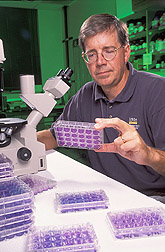This page has been archived and is being provided for reference purposes only. The page is no longer being updated, and therefore, links on the page may be invalid.
|
|
Young African-Americans' Low Vitamin D Levels Reported
By Marcia WoodMay 25, 2006
Low vitamin D levels among young African-Americans participating in a recent study were more common than in several previous investigations, university and Agricultural Research Service (ARS) nutrition experts have found.
The vitamin is essential for strong bones and a robust immune system, according to the study's lead author, immunologist Charles B. Stephensen. He works at the ARS Western Human Nutrition Research Center, located at the University of California, Davis.
Stephensen and his co-investigators have reported their findings in the current issue of the American Journal of Clinical Nutrition.
The scientists based their conclusion on levels of a form of vitamin D in the blood (plasma) of 359 volunteers, aged 15 to 19, tested at sites in 14 American cities. Volunteers were predominantly female African-Americans.
Researchers found that 87 percent of the volunteers had an insufficient amount of what's known as 25-hydroxyvitamin D in their plasma. Though some earlier studies had suggested that more Americans than was previously estimated may be short of vitamin D, the 87 percent figure was unexpectedly high, according to Stephensen.
People who have levels of 25-hydroxyvitamin D at or below 37.5 nanomoles per liter of blood are considered vitamin D-deficient.
Good sources of the nutrient include vitamin D-fortified milk, fatty fish and sunshine, which a natural chemical in skin can convert to a form of the nutrient called previtamin D3.
The study was funded in part by ARS—the U.S. Department of Agriculture's chief scientific research agency—and by the National Institutes of Health, part of the U.S. Department of Health and Human Services.
The study volunteers represented a majority of the participants in the federally funded REACH investigation, short for "Reaching for Excellence in Adolescent Health."
Stephensen worked on the study with colleagues from the University of Southern California at Los Angeles; Iowa State University at Ames; the University of Pennsylvania at Philadelphia, and the University of Alabama at Birmingham.

